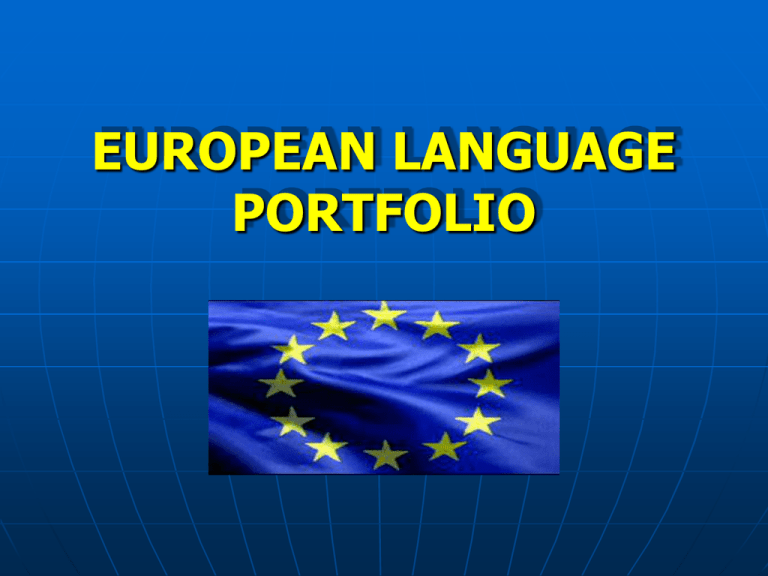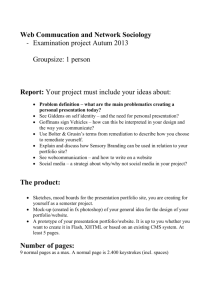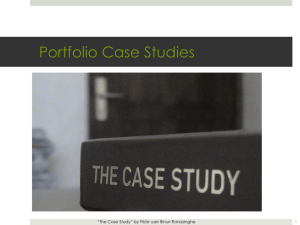EUROPEAN LANGUAGE PORTFOLIO
advertisement

EUROPEAN LANGUAGE PORTFOLIO “There's only one corner of the universe you can be certain of improving, and that's your own self." Aldous Huxley (English writer) DEVELOPMENT The European Language Portfolio (ELP), devised by the Council of Europe's Modern Languages Division and piloted in 15 Council of Europe member states between 1998 and 2000, has been launched throughout Europe during 2001, the European Year of Languages. What is the purpose of the European Language Portfolio (ELP)? The ELP is designed to: encourage the lifelong learning of languages, to any level of proficiency; make the learning process more transparent and to develop the learner's ability to assess his/her own competence; facilitate mobility within Europe by providing a clear profile of the owner's language skills; contribute to mutual understanding within Europe by promoting plurilingualism (the ability to communicate in two or more languages) and intercultural learning. What are the obligatory components of European Language Portfolio (ELP)? A LANGUAGE PASSPORT A LANGUAGE BIOGRAPHY A DOSSIER summarizes the owner's linguistic identity, language learning achievement, and intercultural experience, and includes the owner's assessment of his/her own language competence according to the Council of Europe's Common Reference Levels is used to set intermediate learning goals, review progress, and record significant language learning and intercultural experiences in which the owner collects samples of his/her work and evidence of his/her achievements in second/foreign language learning. How is the European Language Portfolio (ELP) to be used? Owners of all ages can use the ELP to: keep a record of all their language learning, whether it takes place inside or outside the educational system; develop their capacity to plan, monitor and evaluate their own learning; record significant intercultural experiences; collect evidence of their language skills; document their language learning achievements. Language Portfolio (ELP) and the Council of Europe's common reference levels The Common European Framework divides learners into three broad divisions which can be divided into six levels: A Basic Speaker A1 Breakthrough A2 Waystage B Independent Speaker B1 Threshold B2 Vantage C Proficient Speaker C1 Effective Operational Proficiency C2 Mastery The CEFR describes what a learner is supposed to be able to do in reading, listening, speaking and writing at each level. WHAT ARE THE KEY ADVANTAGES OF USING A PORTFOLIO? FOR STUDENTS AND PARENTS FOR TEACHERS A portfolio helps to make the students' learning progress and process visible and noticeable. A portfolio may lead to increased participation and autonomy on the learners' part. MY LANGUAGE PORTFOLIO (sample for 12-17 year-old students) This portfolio is for you! It consists of three parts: Your LANGUAGE PASSPORT What languages do you study? What are your achievements? What does your teacher think? Your LANGUAGE BIOGRAPHY Control your language studying progress. Set new goals for yourself. Find the best ways for their achievement! Your DOSSIER Collect the best works you can be proud of. I. LANGUAGE PASSPORT part 1 Name__________________________________________________________________ Date of birth____________________ Place of birth______________________________ Address_________________________________________________________________ My mother tongue is______________________________________________________ Another language I use every day is__________________________________________ I attend (attended) a school which teaches subjects in a foreign language. Name of school____________________ Address________________________________ Foreign language__________________________ from____________ to_____________ I attended school abroad. Country of school, place____________________________________________________ Name of school___________________________________________________________ Language of instruction_____________________ from _____________to____________ I started to work with European Language portfolio in the____________________ class. Date________________________ I. LANGUAGE PASSPORT part 2 My language study and courses (Language, name of school or language courses, school year, total number of hours, date, teacher’s signature) Other ways I learn languages and get to know other cultures (I have spoken to foreigners from…, I have met people from…, etc.) My other important experience of foreign languages and encountering other cultures outside of school How do I assess myself? (Listening, reading speaking, writing)- Use selfassessment grid Teachers’ assessments (Listening, reading speaking, writing) My results (language exams) II. LANGUAGE BIOGRAPHY I. My learning strategies How can I learn foreign languages? Can I become a better language learner? When I learn a language I... What can I already do? II. Levels of my progress: A, A1,A2, A2+,B1, B1+, B2 (Listening, reading, writing, speaking). My own list what I can already do. What do I want to be able to do? My plans. III. My intercultural experience. Part 1. My intercultural background. Part 2. How I see myself in intercultural contexts. Part 3. A continuing record of intercultural encounters. III. MY DOSSIER The Dossier is my own personal property. In my dossier I can keep: E-mails Pictures Songs Photos Audio or video recordings Written works A reading record Examples of listening, speaking, reading, writing Games or exercises Descriptions and results of project work A personal word list Posters Copies of postcards, letters or e-mail messages sent to a partner school REFERENCE 1. David Little, Radka Perclova. The European Language Portfolio: a guide for teachers and teacher trainers. Council Of Europe. – Strasbourg, 2003. 2. European Language Portfolio. Council of Europe. –Strasbourg, 1997. 3. Francis Goullier. Council of Europe Tools for Language Teaching. Common European Framework and Portfolios. (English edition) – Paris, 2007. 4. Herbert Puchta. English in Mind and the use of a portfolio: what's in it for you and your students? – Internet. http://www.cambridge.org/elt/englishinmind/teacher_resources/portfolio.htm 5. Holec H. Autonomy and Foreign Language Learninng. – Oxford, 1979. 6. Little D. Learner Autonomy. – Dublin, 1991. 7. Modern Languages: Learning, Teaching, Assessment. A Common European Framework of Reference. Council of Europe. – Strasbourg, 2001 8. Objectives for Foreign Language Learning. – Strasbourg, 1986. 9.Rubin J., Wenden A., Learner Strategies in Language Learning. – New Jersey, 1987. 10 Wenden A. Learner Strategies for Learner Autonomy. – New Jersey, 1992. 11. Європейське мовне портфоліо: Методичне видання/Уклад. О. Карп’юк. – Тернопіль: Лібра Терра, 2008. 12. Європейське мовне портфоліо: Проект української версії для учнів 12-17 років/Уклад. О. Карп’юк. – Тернопіль: Лібра Терра, 2008.






